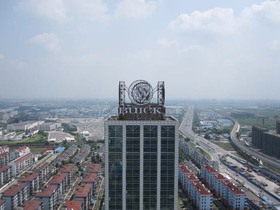The forthcoming book ’SHANGHAI NEW TOWNS - searching for community and identity in a sprawling metropolis’ documents and critically analyzes a number of recent New Towns in the urbanizing region around Shanghai. Most of those New Towns are partly based on western models. A decade ago, a selection of western architects and urban planners was invited to participate in design competitions for thematic core areas. The proposed designs were then translated into a Chinese context and partly realized. They make part of a bigger vision and planning strategy for one of the fastest urbanizing metropolitan regions on earth.
This book is also a coproduction of Chinese and western writers and photographers. It will be presented during the World Expo 2010 in Shanghai, from May 1 to October 31 with the promising theme ’Better City, Better Life’. This topic relates to the moment when almost half of China’s population is living in urban environments. In the coming years many more millions of people are expected to leave the rural areas. In the urgent need to give shelter to all these new citizens, new models are needed for mass accommodation.
Shanghai wants to be a model city, and promises, according to the municipality, to show how the city of the future should be shaped. This cosmopolitan port city is the most important ’bridge’ between China and the rest of the world since the late nineteenth century. It holds an exciting mix of oriental and western architectural styles. After the opium wars, different foreign concessions arose that are still recognizable within the urban fabric. Shanghai is a cosmopolitan mix of east and west, tradition and futurism, rich and poor. As a result of the economic boom many are attracted to this ’New York of the twenty-first century’ to try their luck.
To alleviate the city from the enormous pressure and also to bring benefits to the immediate surroundings of the city, the board of the city province implemented a new strategy in the eighties, based on a shift from the central city model to a poly-nuclear model. With this measure, the municipality wanted to alleviate the enormous pressure on the central city and prevent the countryside from experiencing urban sprawl and also allow the immediate surrounding countryside to benefit from economic growth. Since the end of last century this strategy made several shifts, due to changing policies. This resulted in a fascinating palette of finished and unfinished new towns, villages and satellites.
Probably the most striking example is the ’One City, Nine Towns’ plan, which was started in the year 2001. This "One City, Nine Towns" model displays a preference for Western culture, architecture and urbanism. As a response to the lack of identity that many New Towns are facing, this plan consists of a new medium-sized city (Song Jiang) and nine compact key cities, each one with a thematic blend as core. In consultation with architects and urban developers from represented countries, a Spanish Town, an Italian Town, a German Town, a Dutch Town, a Scandinavian Town, a North American town and a British Town have since been realized. These thematic cores are intended to be germs and become cities of several hundred thousand inhabitants each. The thematic sections are relatively small and include ’only’ a few tens of thousands of houses, designed as a sort of billboard. The rest of the cities are conventionally built up around it in the usual Chinese styles, at breakneck pace. A new modern, a new traditional Chinese town and a new Harbor town are also under construction. A planned ecological town has unhappily been cancelled.
The big question is how this decentralized planning model works out in Shanghai, what is learned from foreign examples and what can be learned from Shanghai? Analogous to the import of classical forms during the Golden Age in the Netherlands, Shanghai is importing postmodern architectural language on a large scale. The big question is why Shanghai, in this post-colonial era, is chosen for the voluntary import of Western urban models and architectural forms. What does this convey to the city? These new ’Chinese’ towns and cities show many common problems, as we know in the western world, such as social segregation, discontinuity of the cityscape and the lack of useful public spaces. The Shanghai model is searching for a balance between government-driven and market-driven urban development.
The economic and political landscape has changed rapidly. Today semi-private developers are involved in the design and implementation. Many Chinese developers appear to have little knowledge of project development. There is a lack of research, so the built houses often don’t match the demand. The extent to which the government is steering is sometimes also unclear. Because of the lacking implementation of public transport and even more because of speculation reasons, many houses, shops and offices remain empty. Some are already in decay and look like ghost towns. Others are very alive and pleasant.
The different conditions and different approaches of each new development result in an interesting palette that shows what can go wrong and what can become a success. Why does the one function better than the other? These new tows form an exciting new laboratory where very different influences are melted into a new reality.


